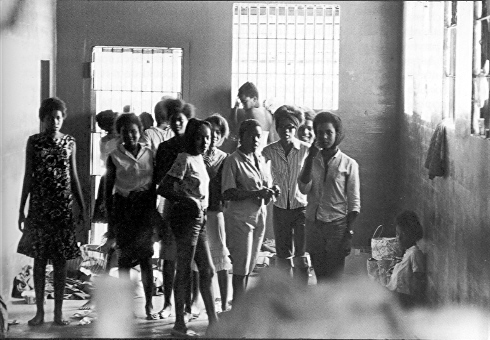In mid-July 1963, approximately 200 African American youth met in downtown Americus, Georgia, to peacefully protest local segregation. After sanctioning violent attacks by a white mob, police moved in to arrest the young protesters. While some protesters were shortly released, 35 African American girls found themselves held in an abandoned Civil War-era prison for almost two months. Known as the “Stolen Girls” or the “Leesburg Stockade Girls,” this incident represented both traditions of youth social justice activism and the heavy hand of white authorities in shaping civil rights politics throughout the Deep South.
Black teens, part of a generation frustrated with the tokenism of change in the early 1960s, played a particularly critical role in challenging racism and inequality in Americus, the county seat of this agricultural region of southwest Georgia. Their activism emerged as part of the Sumter County Movement of 1963-65, political organizing linking diverse but vibrant networks of local African Americans and members of the Student Nonviolent Coordinating Committee (SNCC).
In July 1963, African American youth began to demonstrate daily against segregation at the Martin Theater and the Trailways bus station. Peaceful protests grew raucous as white counter protesters met young activists with taunts and violence. Ultimately, local police borrowed a strategy developed by Albany Police Chief Laurie Pritchett in response to the Albany Movement of 1961-62. To limit press coverage and break down the ongoing protests, Americus officers arrested protesters and held them indefinitely in jails spread out across the region.
Following the Martin Theater protests, thirty-five African American girls—the youngest twelve-years-old and the oldest fifteen—were arrested and, without notice to their parents, transferred to the “Leesburg Stockade,” a small and dank Civil War-era prison located roughly twenty miles outside of Americus in neighboring Leesburg. Not fed for the first two days of imprisonment, they survived the following days on rations of under-cooked hamburgers and egg sandwiches provided by jailers. Sleeping on dirty mattresses and without a working toilet, the girls shared their space with mosquitoes, gnats, and, on one occasion, a snake thrown into the room by the guards. SNCC photographer Danny Lyon finally located them after weeks of searching throughout the region and alerted community members. Lyon’s photos, however, were published in SNCC’s newspaper, The Student Voice, Jet magazine, the Chicago Defender, and other African American newspapers throughout the country. The photographs documented the brutality of Jim Crow in rural Georgia for the entire nation. The girls were finally released in mid-September, the same week as the Sixteenth Street Baptist Church was bombed in Birmingham. The girls were never charged with a crime, but in perhaps the ultimate indignity, many parents later received a bill with a charge of two dollars for every day of their child’s imprisonment.
Many of the Stolen Girls continued to be active in the Sumter County Movement after their release from the Leesburg Stockade but received little recognition until the twenty-first century. Some of the participants who have continued to speak out about their experiences include Sandra Mansfield, Annie Lou Ragans, Lulu Westbrooks-Griffin, Carolyn DeLoatch, Carol Barner-Seay, Dianne Dorsey Bowens, Emmarene Kaigler-Streeter, and former Americus Councilwoman, Shirley Green-Reese. The history of the Stolen Girls represents the commitment of youth, and specifically African American girls, to the larger freedom struggle of the 1960s.

